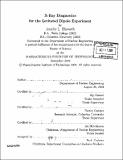X-ray diagnostics for the Levitated Dipole Experiment
Author(s)
Ellsworth, Jennifer L
DownloadFull printable version (2.914Mb)
Other Contributors
Massachusetts Institute of Technology. Dept. of Nuclear Engineering.
Advisor
Jay Kesner and Darren Garnier.
Terms of use
Metadata
Show full item recordAbstract
Initial plasma experiments in the Levitated Dipole Experiment focus on producing hot electron, high beta plasmas using a supported dipole configuration. Plasmas are created using multifrequency ECRH and it is therefore expected that most of the plasma energy will be stored in the fast electrons, Te > 100 keV. As a consequence, x-ray flux from bremsstrahlung emission is expected to be easily detectable. The energy spectrum of the x-ray emission below 740 keV is measured by a four channel pulse height analyzer using cadmium zinc telluride detectors. In addition, a single sodium iodide detector, which views energies up to 3 MeV, measures the intensity of the hot electron population. The electron temperature may be inferred from the x-ray energy. X-ray measurements are essential in diagnosing the effectiveness of various ECRH configurations. The design and installation of the pulse height analyzer are discussed in addition to the preliminary results from first plasma experiments.
Description
Thesis (S.M.)--Massachusetts Institute of Technology, Dept. of Nuclear Engineering, 2004. Includes bibliographical references (p. 77-79).
Date issued
2004Department
Massachusetts Institute of Technology. Department of Nuclear Engineering; Massachusetts Institute of Technology. Department of Nuclear Science and EngineeringPublisher
Massachusetts Institute of Technology
Keywords
Nuclear Engineering.